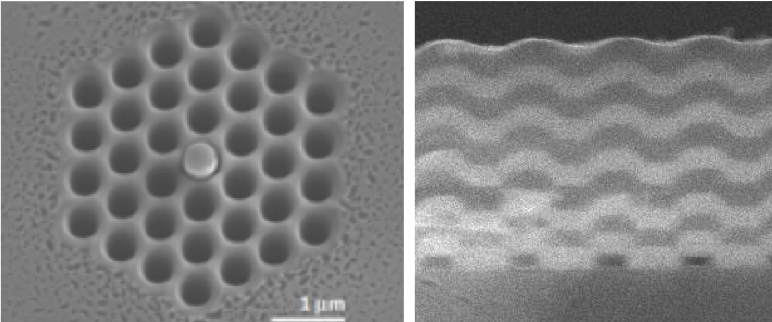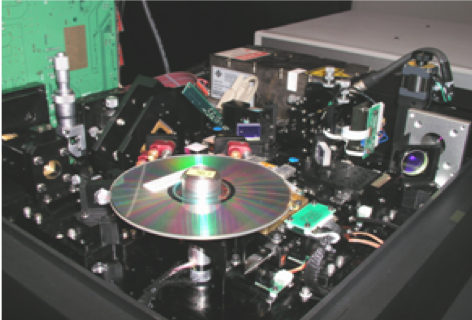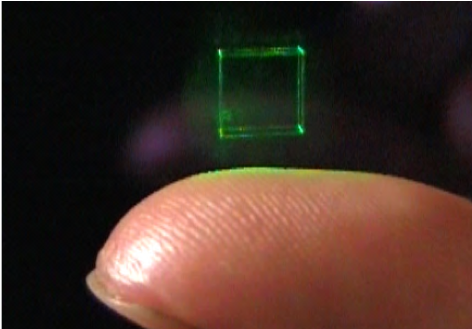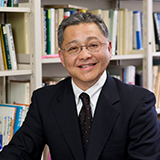
ここからコンテンツです。

Realizing 3D Displays and Hologram Memory through Nanomagnetic Materials
Mitsuteru Inoue

Looking back on his career as a researcher, Professor Mitsuteru Inoue, who is celebrating his sixtieth birthday this year, says he has lived up to his former teacher’s instruction, "Do not imitate." Following these words of wisdom, Professor Inoue has created new devices and systems using groundbreaking magnetic materials. Professor Inoue, is currently pushing the frontiers of research in areas such as 3D displays which do not require special glasses, ultra-high density recording systems using holograms, and new theoretical calculation elements which do not require the flow of an electric current. We caught up with Professor Inoue to talk with him about his main research achievements and future prospects.
Interview and report by Madoka Tainaka
Controlling light with magnetophotonic crystals
"All of my research is based on the interaction between magnetism and some other physical phenomenon. Magnetism and light, magnetism and ultrasonic sound, magnetism and heat − all combine magnetism and some other physical phenomenon. My aim is to develop systems that have never been created before." says Professor Inoue.
Professor Inoue’s research usually involves the use of magnetic garnet containing iron as a base material. Magnetic garnet is a magnetic insulator that transmits light and is heavily used in jewelry. When light is transmitted, the magnetism and light combine to develop a magneto-optical effect in which the polarization state changes. In other words, it is said that the characteristic of this material is that the magnetism can control the characteristics of light.
"However, if you break down what we mean collectively by ‘light’, it includes various wavelengths of light from infrared to visible light and ultraviolet. Far infrared light used for optical communications has a wavelength of about 1.55 μm, while ultraviolet light used for Blu-ray Discs has a wavelength as short as 0.4 μm. In order to combine magnetism and light in accordance with each wavelength, the material properties must be changed, so to that end we have been developing various materials. However, such development takes a great deal of time. In addition, most of the materials that we develop must be discarded without ever being used for reasons such as prohibitively high cost."

Faced with this situation, Inoue came to look at combining existing materials. He worked on the development of an artificial magnetic lattice with the desired characteristics by sorting magnetic substances on the nanoscale into a lattice pattern. In fact, this idea is the same as the "photonic crystal" concept proposed by Yablonovitch of the USA in 1987, which offers properties such as three-dimensional confinement of light through the periodic arrangement of materials with different refractive indices. Since magnetic material is used for the photonic crystal, Professor Inoue calls the material he has developed a magnetophotonic crystal.
"All the properties of light can be predicted, and it is a big advantage that we can perform simulations in advance on a computer even with a three-dimensional nanoscale structure. In concrete terms, we interpose magnetic substances between different kinds of dielectric multilayer films, then, by changing the thickness of the magnetic material, we can now control the light flexibly by strengthening the magnetic coupling for each wavelength of light."
Enabling ultra high density recording with holographic memory
Inoue and his colleagues are developing various new devices and systems based on these magnetophotonic crystals.

One of these is the world's first hologram memory. This technology can record and playback on media using the interference and diffraction of light from superimposing two light sources. By slightly changing the incidence angle of the reference light, it is possible to write several pieces of data in the same place, so that 200 movies can be stored on one disc the size of a DVD.
According to Professor Inoue, "In 1999 we launched a venture company from TUT called Optware and worked on the commercialization of a collinear hologram memory that can be miniaturized by coaxially arranging the signal light and the reference light, that we developed at the Research Center for Advanced Photonic Information Memories at TUT. It was certified as an international standard in 2007, and then just before commercialization the financial crisis occurred and the project stopped."
However, the R&D itself has continued until now. The information circulating in the world continues to increase, and innovative technology that can record and playback large amount of data at high density, high speed, and low energy is undoubtedly needed. For this application, the above-mentioned magnetic materials will be useful.
"Previously we used photopolymers that solidify with light on the recording medium, but since they were organic materials, we knew that they would deteriorate over time, so we decided to use a magnetic material that could ensure stable long-term recordings. We have already developed a magnetic hologram that can write and playback with zero error and zero energy."
Another part of Professor Inoue’s research that is attracting attention is the world's first 3D display using nanomagnets. In the movie "Star Wars" (1977), there is a famous scene where R2-D2 projects a three-dimensional hologram of Princess Leia. Professor Inoue says he wants to realize exactly this type of 3D imaging.

"We use a thin film magnetic material for the display, reduce the pixel size to the nanoscale, and reverse the magnetism using the heat of the light. This allows us to create a 3D image with a wide viewing angle of 30 degrees without using special glasses. Currently, the material that we can write on is small, so the playback image is as small as a few centimeters, but we are conducting research aiming at playing larger videos."
Professor Inoue and colleagues are also advancing the miniaturization of the device aiming at 3D display applications such as head up displays for vehicles and projection from mobile devices. In addition, since a huge amount of data is required to project moving images, they are also working in parallel to combine the technology with the above-mentioned hologram memory.
Developing new computers that can perform calculations without the flow of a current
In addition, since the influence of heat generated by electric current is a major problem when creating nano-scale elements in information devices that are indispensable to the advanced information age, Professor Inoue and colleagues are working in collaboration with domestic and overseas research institutions such as MIT, Moscow State University, and Keio University to develop new calculation elements and their peripheral technologies that do not require the flow of current.
"Instead of electrons, we use spin, which is a magnetic property of an electron. Spin can take two states − upward or downward, and has the property of transmitting waves into the crystal by the interaction between spins. Our idea is to try and make computations using the phase interference of this spin wave by strengthening or weakening the wave. We have already processed magnetic garnet into the form of a fork and succeeded in inputting spin waves from the three prongs, causing phase interference at the connection point and outputting the result at the main part. We have recently created the word ‘magnonics’ to accelerate research in this field."
Currently, Professor Inoue and his team are conducting studies to process small chips by cutting holes in thin garnet to create lines for miniaturization of elements. Also, although current is not used for calculation, at present it is used for exciting spin waves and detecting the results of calculations, so Inoue is trying to develop methods that do not use current.
Professor Inoue concludes, "We will actively work on launching ventures and strive to develop magnonics as a globally applicable technology."
Reporter's Note
Professor Mitsuteru Inoue majored in electromagnetics at Toyohashi University of Technology and taught at a technical college for ten years after acquiring his master's degree. During this time, he had no access to experimental or measurement equipment, so he became absorbed in calculating combinations of magnetic materials and designing devices with the mainframe computer that was the only tool available to him. He says that this became a great help to his later research. "After completing my doctoral degree, I gained confidence and went back to TUT, but I ended up leaving the laboratory after a big argument with my professor. I went back to the situation of no equipment other than a personal computer. Perhaps it is from this experience that I learned to do imaginative and original work." Inoue says, laughing.
Staying true to the philosophy of never imitating has its risks, and three of Inoue’s ventures have failed so far, but with no loss of enthusiasm, he is taking on the challenge of the fourth. We have high hopes for him!
Reference
3Dディスプレイやホログラムメモリなどをナノ磁性材料で実現
今年、還暦を迎える井上光輝教授は、これまでの研究者人生を振り返って、恩師の教えである「人の真似をするな」という信念を貫いてきたと語る。その言葉通り、井上教授は磁性材料を用いながら、誰も手がけたことがない新しいデバイスやシステムを生み出してきた。特殊なメガネを必要としない3Dディスプレイをはじめ、ホログラムを使った超高密度記録システム、電流を流さない新しい理論演算素子など、未踏の研究に挑んできた井上教授に、主な研究業績と未来展望について聞く。
磁性フォトニック結晶で光をコントロールする
「私の研究はすべて、磁気と何らかの物理現象との相互作用を基本としています。磁気と光、磁気と超音波、磁気と熱など、いずれも磁気と何らかの物理現象を組み合わせ、これまで誰もつくったことがないシステムの開発をめざしてきました」と井上教授は語る。
そのベースの材料として用いてきたのが、主に鉄を含んだ磁性ガーネットだ。磁性ガーネットは、磁石の性質を持つ絶縁体で、宝石として重用されるように、光を透過する性質を持つ。そして光が透過する際に、磁気と光が結合して、偏光状態が変化する磁気光学効果を発現する。つまり、磁気で光の特性をコントロールできる点が、この材料の特徴だという。
「ただし、光と一言で言っても赤外から可視光、紫外まで、さまざまな波長の光があります。光通信で使う遠赤外であれば波長は1.55μmほど。一方、ブルーレイディスクに使用される紫色の光の波長は0.4μmと短い。それぞれの波長に合わせて磁気と光を結合させるには、材料特性を変えなければなりません。そのためにこれまで、さまざまな材料が開発されてきました。しかし、材料開発には大変な苦労が付きまとい、開発までには膨大な時間がかかります。しかも、開発された材料のほとんどが、コストが高いなどの理由により使われないまま消えていきます」と井上教授。
そこで目をつけたのが、既存材料の組み合わせだ。井上教授は、磁性体をナノスケールで刻んで並び替え、格子状に組み合わせることで、求める特性を備える人工磁気格子の開発に取り組んできた。じつはこの発想は、1987年に米国のヤブロノビッチによって提案された、屈折率の異なる材料が周期的に並んだ構造により、光の三次元閉じ込め効果などを持つ「フォトニック結晶」と同じであることがわかった。そのフォトニック結晶に磁性材料を用いることから、井上教授は自ら開発した材料を磁性フォトニック結晶と呼んでいる。
「光の特性というのはすべて予測でき、ナノスケールの三次元構造であっても、コンピュータであらかめシミュレーションできるのが大きな特長です。具体的には、磁性体を違う種類の誘電多層膜で挟み、磁性体の厚みを変えることで、それぞれの光の波長ごとに磁気の結びつきを強め、自在に光を制御できるようになりました」
超高密度記録を可能にしたホログラムメモリ
井上教授らは、この磁性フォトニック結晶をベースに、さまざまな新しいデバイスやシステムを開発している。
その一つに、世界初となるホログラムメモリがある。これは、二つの光を重ね合わせた際の光の干渉と回折を利用してメディアに記録・再生するというもの。参照光の入射角をわずかに変えることで、同じ場所にいくつものデータを書き込むことが可能で、DVDと同じ大きさのディスク1枚に200本分もの映画を収めることができる。
「1999年にはオプトウエア社という大学発のベンチャー企業を立ち上げ、本校の先端フォトニック情報メモリリサーチセンターで開発してきた、信号光と参照光を同軸に配置することで小型化できるコリニア方式ホログラムメモリの製品化を進めてきました。2007年には国際標準規格にも認定され、まさに製品化の目前というところで、リーマンショックが起こり、事業がストップしてしまったのです」と井上教授は言う。
しかし、研究開発自体は現在まで続けてきた。世の中に流通する情報は増え続けており、大容量データを高密度に高速に、そして低エネルギーに記録・再生できる革新的技術は間違いなく必要とされているためだ。その際、先の磁性材料が役立つという。
「以前は記録媒体に、光で固まるフォトポリマを使っていたのですが、有機材料なので経年劣化することがわかっていました。そこで、長期に安定的に記録できる材料として磁性体を用いることにしたのです。すでに、低エネルギーで、エラーゼロでの書き込み再生ができる磁気ホログラムを開発しています」
もう一つ、井上教授らの研究で注目されるのが、こちらも世界初となるナノ磁性体を使った三次元ディスプレイだ。映画『スターウォーズ』(1977年)の中で、R2-D2が空間にレイア姫の立体的なホログラムを投射する有名なシーンがあるが、まさにあの立体映像を実現したいのだという。
「ディスプレイに薄膜の磁性材料を用いて、ピクセルサイズをナノスケールまで小さくし、光の熱で磁性を反転させることで、特殊なメガネを用いることなく30度という広視野角を持つ立体画像の再生に成功しています。現在は、書き込むことができる材料が小さいので、再生画像も数cmと小さいのですが、より大きな動画の再生をめざして研究を進めています」
井上教授らは、3Dディスプレイの応用例として車のヘッドアップディスプレイやモバイル機器での投射をめざして、装置の小型化も進めている。また、動画を投影するにはさらに膨大なデータが必要となることから、先述のホログラムメモリとの連携も並行して進めていくという。
電流を流さずに計算する新しいコンピュータの開発へ
さらに井上教授らは、高度情報化社会に欠かせない情報機器の素子のナノ化に伴い、電流に由来する発熱の影響が大きな課題となっていることを踏まえて、電流を用いない新たな演算子とその周辺技術について、マサチューセッツ工科大学やモスクワ大学、慶應義塾大学など、国内外の研究機関とさまざまにコラボレーションしながら、共同研究を進めている。
「電子の代わりに用いるのが、電子の持つ磁石の性質であるスピンです。スピンは上向き/下向きなどの二つの状態をとり、スピン間の相互作用によって、結晶内に波を伝える性質を備えています。このスピン波の位相干渉を利用して、波を強めたり弱めたりして、演算をしようというのが我々の考えです。すでに、先の磁性ガーネットをフォーク型に加工して、三つの枝からスピン波を入力して、接続点で位相干渉させ、幹の部分で結果を出力することに成功しました。この分野の研究を加速させるため、マグノニクスという言葉をつくって取り組んでいるところです」
現在、素子の微細化に向けて、薄いガーネットに穴を開けてラインをつくり、小さなチップに加工する研究も行なっている。また、現在は演算には電流を使わないものの、スピン波の励起や演算結果の検出には電流を用いているため、電流を使わない方法に挑む。社会実装のために、ベンチャーの立ち上げなども積極的に取り組み、マグノニクスの発展に邁進していくと語った。
(取材・文=田井中麻都佳)
取材後記
豊橋技科大で電磁気学を専攻、修士を取得した後、高専で教えること10年。その間、実験や測定のための装置や設備は何もなく、実験ができない中で、唯一、自由に使うことができたメインフレームのコンピュータで磁性材料の組み合わせやデバイスの設計などを計算することに没頭したという井上教授。それが後の研究に大いに役立つことになったと語る。「博士を修了した後、自信をつけて豊橋に戻ったのですが、教授と大げんかしてしまい、研究室を離れることになってしまい(笑)。またしてもあるのはパソコンだけという環境を経験しました。そういう経験の中で一から創意工夫をする姿勢が身についたのかもしれません」と笑う。
人と同じことはやらないという信念の下、これまで潰したベンチャーは三つ。それでもめげることはなく、四つ目に挑みたいと意気込む。大いに期待しています!
Researcher Profile

Dr. Mitsuteru Inoue
Professor of the Graduate School of Toyohashi University of Technology and IEEE 2018 Distinguished Lecturer
Mitsuteru Inoue received the B.S. degree in information engineering and the M.S. and Dr.Eng. degrees in electrical and electronic engineering in 1981, 1983, and 1989 from Toyohashi University of Technology (TUT), Japan. He was an associate professor at TUT from 1993 to 1996, and with the Research Institute of Electrical Communication, Tohoku University, from 1997 to 1999. From 2001 to 2013 he served as professor in the Department of Electrical and Electronic Engineering, TUT. Since 2014 he is jointly serving as professor of the Graduate School of TUT and as an executive trustee and vice president of TUT. He was a visiting professor at Stanford University in 2003 and at Moscow State University in 2004. His research interests include spin-coupled wave propagation phenomena in amorphous alloy and magnetic garnet thin films, including phase modulation of magneto-surface-acoustic-waves, control and phase modulation of optical waves, and control of high-frequency magnetostatic and spin waves, together with their applications in magneto-optical (MO) spatial light modulators, three-dimensional MO displays, non-destructive MO imaging, magnetic hologram recording, and spin-wave logic circuits.
Reporter Profile

Madoka Tainaka is a freelance editor, writer and interpreter. She graduated in Law from Chuo University, Japan. She served as a chief editor of “Nature Interface” magazine, a committee for the promotion of Information and Science Technology at MEXT (Ministry of Education, Culture, Sports, Science and Technology).
ここでコンテンツ終わりです。
